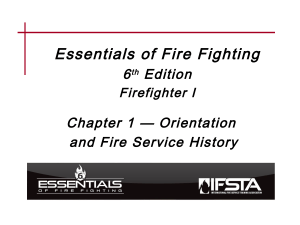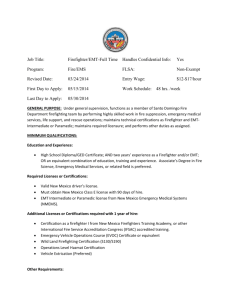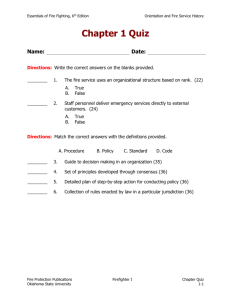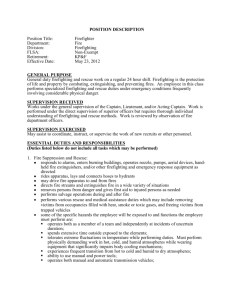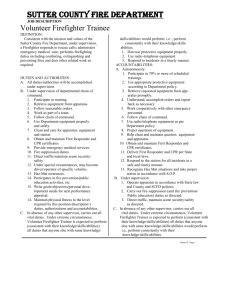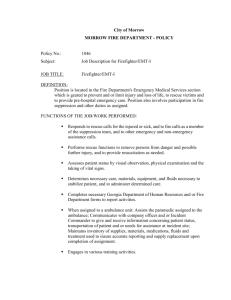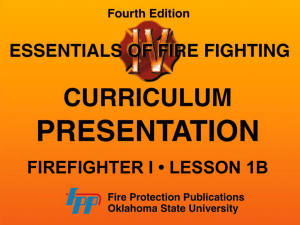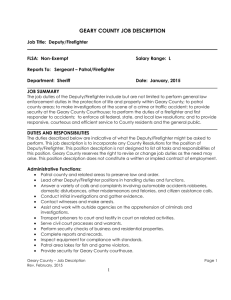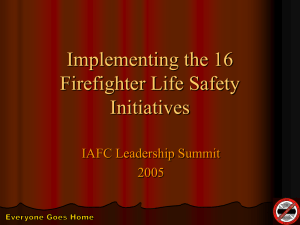IFSTA_files/Chapter 01 FFI
advertisement
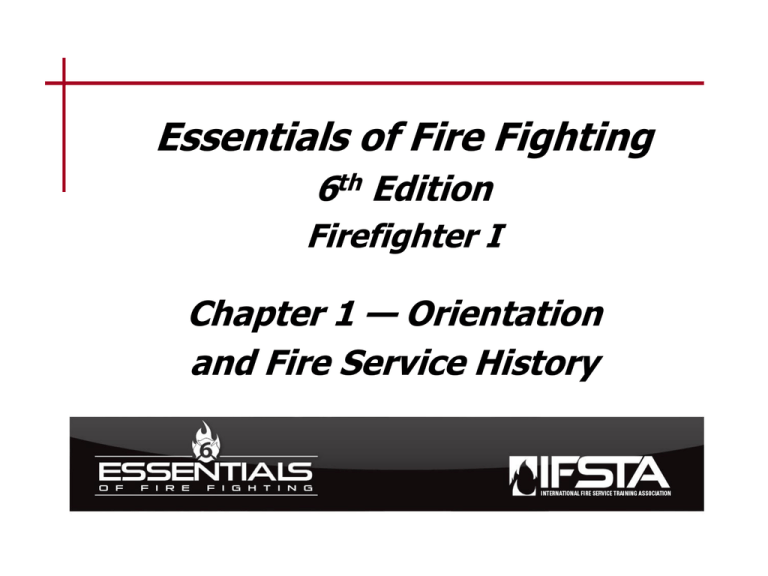
Essentials of Fire Fighting 6th Edition Firefighter I Chapter 1 — Orientation and Fire Service History Learning Objective 1 Summarize the history of the fire service. 1–1 Fire service history is an important part of understanding current practices. Colonial North America Industrial revolution influence • Jamestown • Boston • New Amsterdam (New York) • Philadelphia • Steam pumpers • Iron structural members • Steel replaced iron • Skyscrapers • NFPA® 1–2 Significant historical events result in current laws and equipment. Courtesy of Spinner Publications 1–3 (Cont.) Significant historical events result in current laws and equipment. 1–4 REVIEW QUESTION How were early fire organizations started? 1–5 There are general trends of change in the modern fire service. Fire prevention and public safety education Hazardous materials Professionalization for the fire service Firefighter safety Emergency medical services Terrorism Natural disasters (All hazard mitigation) Community-based fire protection 1–6 REVIEW QUESTION What are some of the areas that have changed significantly in the 20th Century for fire service in North America? 1–7 Learning Objective 2 Explain the organizational characteristics, cultural challenges, and cultural strengths that influence the fire service. 1–8 Fire service culture is influenced by its organization and cultural challenges. Culture Organizational Characteristics Cultural Challenges 1–9 • Based on history and tradition • Grows with education • Command structure • Ranks • Uniforms • Teamwork Fire service culture develops specific cultural strengths. Integrity Moral character Work ethic Pride Courage Loyalty Respect Compassion 1–10 REVIEW QUESTION How do organizational characteristics, cultural challenges, and cultural strengths influence the fire service? 1–11 Learning Objective 3 Describe the mission of the fire service. 1–12 REVIEW QUESTION What is the mission of the fire service? 1–13 The fire service mission establishes department organization. Save lives Fire Service Mission Protect property and environment 1–14 Learning Objective 4 Describe the organization of fire departments. 1–15 Department organization is based on a system of rank tied to specific duties. 1–16 Fire department types are determined by how the organization is funded. Public Private 1–17 Types of staffing vary based on funding and duties assigned at the station. Career Volunteer • On-call Combination 1–18 Departmental duties are separated based on who personnel support. Line personnel Staff personnel Directly to external customers Support line personnel Courtesy Bob Espositio 1–19 REVIEW QUESTIONS What are the three main types of staffing found in the fire service? What is the central difference between line functions and staff functions? 1–20 Learning Objective 5 Distinguish among functions of fire companies. 1–21 The basic organization of a fire company is based on assigned duties. Company Basic unit with the officer at top Battalion or district Companies located in response area 1–22 Operations division Manages day-today operations Fire company duties vary depending on their main purpose. Courtesy of Ron Moore, McKinney (TX) FD Truck (ladder) Company Engine company Rescue squad/ company Brush company 1–23 (Cont.) Fire company duties vary depending on their main purpose. Emergency medical/ ambulance company Courtesy of Edwin Jones Hazardous Materials company Special rescue company Aircraft rescue and fire fighting company •1–24 REVIEW QUESTION How are the duties of an engine company different from a rescue squad/company? 1–25 Learning Objective 6 Summarize primary knowledge and skills the firefighter must have to function effectively. 1–26 Learning Objective 7 Distinguish among the primary roles of fire service personnel. 1–27 Fire department personnel must meet specific qualifications. Professional Educational Age Medical Job-related physical fitness Training in basic medical care 1–28 Line functions form the foundation of the uniformed part of fire service. Emergency Operations Division Fire Fighter I Fire Fighter II (Cont.) 1–29 Line functions form the foundation of the uniformed part of fire service. Courtesy of Doug Allen and Ames (IA) FD Emergency Operations Division Airport firefighter Hazardous materials technician Fire apparatus driver/operator 1–30 (Cont.) Line functions form the foundation of the uniformed part of fire service. Emergency Operations Division Wildland firefighter Fire department incident safety office Rescue technician Fire police personnel 1–31 (Cont.) Line functions form the foundation of the uniformed part of fire service. Fire department officer Emergency Operations Division Company officer District/ Battalion chief Assistant/ Deputy Chief Fire Marshal Fire Chief •1–32 (Cont.) Line functions form the foundation of the uniformed part of fire service. Emergency Operations Division Emergency medical responders Emergency medical technicians Advanced emergency medical technicians Paramedics (Cont.) 1–33 REVIEW QUESTION What is the primary difference between Firefighter I and Firefighter II duties? 1–34 Line functions form the foundation of the uniformed part of fire service. Fire prevention division Fire prevention officer/ inspector Plans examiner Fire and arson investigator 1–35 Public fire and life safety educator Fire protection engineer/ specialist Staff functions support and train members of the fire service. Training division Fire department health and safety officer Clerical staff Telecommunicators Information systems personnel Fire alarm personnel Apparatus and equipment maintenance personnel 1–36 • Instructors • Training officer/ chief of training REVIEW QUESTION How are qualifications for different line positions regulated? What types of staff functions support and supplement line functions? 1–37 Learning Objective 8 Describe fire department organizational principles. 1–38 Fire service members must understand department organizational principles. Chain of command Unity of command (Cont.) 1–39 Fire service members must understand department organizational principles. Span of control Division of labor Discipline 1–40 REVIEW QUESTION What are the organizational principles of the fire service? 1–41 Learning Objective 9 Locate information in departmental documents and standard or code materials. 1–42 Learning Objective 10 Distinguish between fire department SOPs and rules and regulations. 1–43 Personnel must know how to locate information in fire department regulations. First, ask your supervisor May be posted 1–44 May be on file at administrative office The fire service is regulated by a variety of rules and procedures. Policies • Guide to decision making • Set boundaries, establish standards of conduct • Detailed plan of action • List step-by-step for conducting Procedures policy (Cont.) 1–45 REVIEW QUESTION What steps can be taken to locate information in department policies? 1–46 The fire service is regulated by a variety of rules and procedures. Laws, Statutes, or Ordinances Codes and standards Orders and Directives • Federal • State/provincial • Local • Standard – Set of principles, protocols, procedures • Code – Collection of rules and regulations • Issued from top command • Used to implement departmental policies 1–47 REVIEW QUESTION How are policies and procedures different from one another? 1–48 Learning Objective 11 Explain the ways the fire service may interact with other organizations. 1–49 Fire service personnel will interact with various other organizations. Law enforcement Courtesy of Tim Burkitt/FEMA Emergency disaster management EMS and Hospitals (Cont.) 1–50 REVIEW QUESTION What other organizations may provide services to the public along with firefighters? 1–51 Fire service personnel will interact with various other organizations. Utility companies Public works Media Other agencies 1–52 REVIEW QUESTION What should a firefighter do when approached by members of the media? 1–53 Summary • Firefighting is a profession with a long and proud tradition of service to the community. (Cont.) 1–54 Summary • To perform as a firefighter you need physical skills, and knowledge of the regulations that govern your organization, the laws that regulate fire service, the incident command system, as well as, an understanding of agencies that interact with the fire department. 1–55
